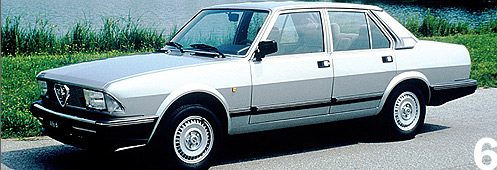After a long waiting period in 1979 Alfa introduced its new E segment flagship, named as 6.
At the developing the manufacturer tried for using the same style as at the Alfetta, but 6 seemed more imposing because of the big boot capacity and hood. In that time the 0.41 drag-coefficient was respectable.
Its engine was a brand new 2.5 litre V6, which produced 158 HP at 5600 rev. Six carburettors fed this unit, and belt driven camshafts regulated the 2 valves per cylinder. The drive train remained tradioinal, the engine and the gearbox was in the front, the differential was in the rear. Alfa Sei (6) used a de-Dion rear and independent front suspension, just like the Alfetta, but the gearbox was next to the engine (compared to the Alfetta, where the gearbox was in the rear), and Sei was available with a 3 gear automatic gearbox.
The second series came out in 1983 and Alfa made small, but noticeable changes. However the chassis remained the same, the double rounded front lights were changed into a four square one, new front and rear bumpers, radiator mask and rear lights were made for the 6. The interior was renewed too; new tracing and new upholstery were made, and at the engine, Alfa replaced the carburettors to Bosh L-Jetronic mechanic injection system, but the max output remaind the same.
At the first facelift Alfa introduced a 2 litre (135 HP) version with carburettors, and a 2.5 litre 5 cylinder VM diesel engine which produced 105 horses.
For the premiere of the second series a new prototype was made, named as Delfino. This car was the coupé version of the 6.
Alfa 6’s prestige rose when Pope John Paul the second ordered an Alfa 6.
















